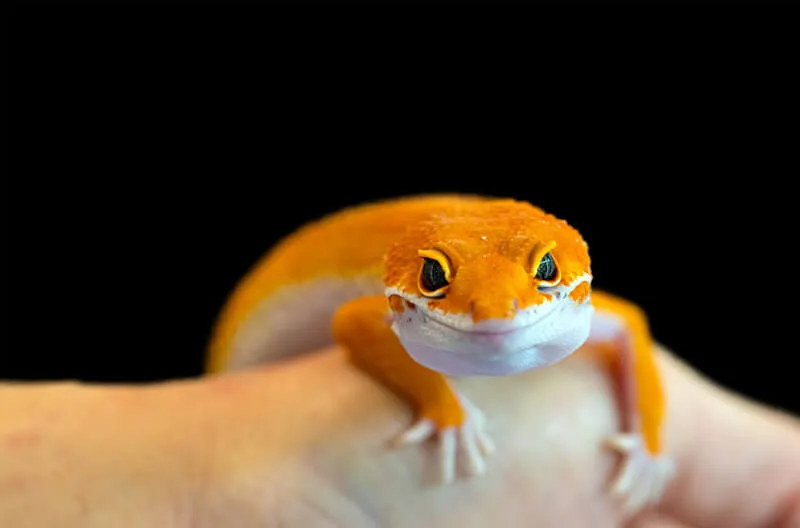 Having a leopard gecko is undoubtedly a wonderful thing, but we can’t help but wonder about certain things. Suppose the power went out, and your heat lamps all shut off. How much time would you have before things got bad?
Having a leopard gecko is undoubtedly a wonderful thing, but we can’t help but wonder about certain things. Suppose the power went out, and your heat lamps all shut off. How much time would you have before things got bad?
How Cold Does It Have to Be for A Leopard Gecko to Die? Leopard geckos have to have a body temperature of at least 86°F or 30°C. Supposing the temperature was mild, such as 60°F or 15.5°C, the leopard gecko could live for a few days with zero heat. Extreme temps would likely lessen this survival time.
As you can see, having no heat is a serious situation and must be addressed. Keep reading to learn about keeping the habitat at the right temperature and how to keep your leopard gecko safe.
Table of Contents
What Happens When Leos Get Too Cold?
If a leopard gecko is without adequate body temps, they may become impacted, meaning they cannot digest or eliminate waste properly.
They may also become malnourished as they cannot afford to spend energy on eating and the subsequent digestion that comes with it. Lack of eating, proper digestion, and elimination can lead to death or injury in your leopard gecko.
The Power Went Out and I Have A Leopard Gecko
If the power went out, do not panic. There are things you can do now to keep your leo warm.
Use A Generator
Make use of a generator to keep the power going to your reptile setup. Small generators do not cost a bundle and are available at most retailers. Be sure you follow all manufacturer instructions to operate the generator safely.
This generator (check it out here) can keep your leopard gecko warm for a couple of hours during a power outage and it’s not too pricy.
Use Heating Packs
Hand warmers are great ways to keep a leo warm, and they last for hours and are cheap. Buy a LOT of these- as many as you can afford- and opt for the longest-lasting ones you can find. We recommend these heat packs since they were made for shipping reptiles, fish, or feeder insects.
Always follow the instructions when using heat packs. It might be a good idea to wrap them up in washcloths, so your leo doesn’t have direct contact with the heat pack.
Your Car Can Help
Use your car. You can temporarily keep your leo warm by going to the car with your leo in his portable carrier. Make sure the car is outside when you do this and make sure there is adequate gas in the car as you may need to run it for a while before the power kicks back on.
Ask A Friend
Ask A Friend for Help. Do you have a friend or neighbor that could house your leo temporarily? Perhaps their house has power.
If you feel comfortable doing so, ask if they could possibly house your leo for just a little while until power kicks on again. Make sure you thank them and offer to repay their kindness in some way.
Snuggling Could Help
If your leo is OK being handled, you can hold them close to you to help keep them warm. You can wrap them up and hold them close to you. Take care not to put fingers in your mouth and wash hands thoroughly after handling your leopard gecko.
Fundamentals of Good Heating
A leo getting too cold does not always happen because of power outages. Some leo owners do not know how to set up a
In this section, we will talk about what you need to set up a good, healthy heating setup in your leopard gecko habitat.
To make sure you measure the temperature accurately, we highly recommend getting this temperature gun instead of the usual reptile thermometers. Most cheaper thermometers are not accurate at all which could lead to health problems in your leo.
- Aim for 88°F to 92°F on the floor in the warm side near the basking area.
- Aim for the same temps underneath the warm, dry hide.
- Air temps about 6 inches off the ground in the warm area need to be 80°F to 83°F.
- Temps inside the moist hide need to be 83°F-90°F.
- Air temps about 6 inches above the ground on the cool side should be 73°F-76°F.
- At night, keep the
tank temp at 67°F-74°F.
Keep Track of Temps
You should keep track of temperatures daily using a spreadsheet, or even just pen and paper. Recording this will help you understand how the habitat is doing in terms of heat, and you can also notice if the temperatures are dropping and equipment is in need of replacement or repair.
Proper monitoring works like this: Use the temperature gun we recommend or install three thermometers inside your
Put one of them just above the floor on the warm side and put the other 6 inches above the ground on the cool side. Now take a third thermometer and put it 6 inches above the ground in the warm area.
Placing all of these thermometers will help you keep track of the
Heating the Tank
Leopard geckos don’t need ultra-bright lights in their
So, how in the world are we to heat the leopard gecko’s
You can use an under-tank heat source and stick that just below the
You might also use a ceramic heat emitter (CME) to provide supplemental heat if you find it’s not getting warm enough. CMEs are seen as the best heat source by many reptile owners.
We recommend getting this ceramic heat emitter here as it is quite cheap (2 pack) and the 60W version should be sufficient for most 20-gallon tanks.
Low-watt incandescent bulbs are good as a means of recreating day and night conditions aside from providing your little gecko with some additional heat.
Do you already live in a warm place, or is your house already really warm? If you can keep
If the temperature in the 
Use A Heat Mat
A heating mat or heat pad is another fundamental tool to keeping your leopard gecko’s
It goes on the warm side of your
A heat mat combined with a substrate like paper towels or reptile carpets make for a very comfortable and clean setup (even though we prefer a setup with a more natural substrate).
Some of you will have ceramic tiles, and that’s OK too- for that, you will heat using an overheat ceramic bulb. Your leo will come out and use the residual heat from the tiles to stay warm.
However, you have to keep the ceramic heat emitter on- no switching it off at the end of the night unless the temps can stay adequate. This method doesn’t work too well with other substrates other than ceramic tiles.
Ceramic bulb use should be cautious if you have a
The bottom line? A 20 to 30-gallon
Conclusion
Having a plan in place should the power go out and knowing what makes a good heat setup for your leo will keep them feeling great in all conditions. Enjoy staying warm with your leo!
- Enchi Ball Python: A Unique and Stunning Morph of Python regius - March 27, 2025
- Emerald Tree Monitor: The Enigmatic Green Guardian of the Rainforest - March 26, 2025
- The Egyptian Cobra (Naja haje): A Fascinating Serpent - March 25, 2025
